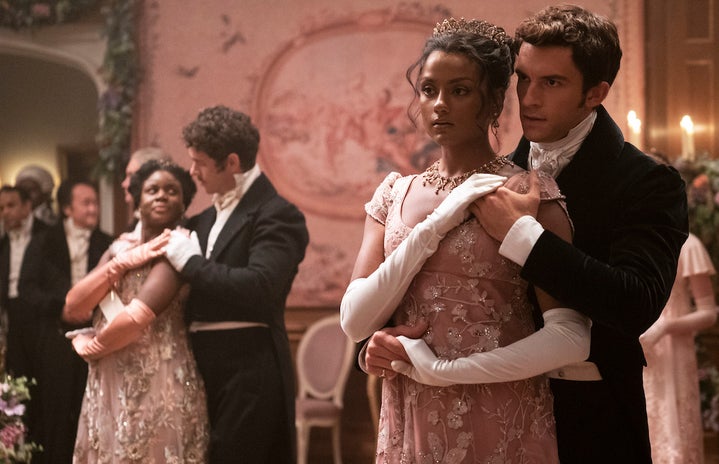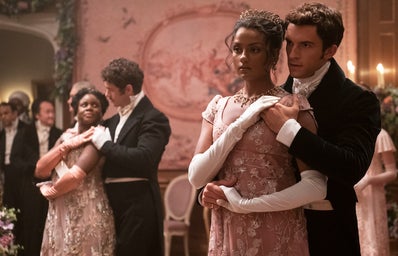After learning that Regé-Jean Page, more fondly known as “The Duke of Hastings,” was not going to be returning for Season 2 of Bridgerton, many were skeptical of how the second season would turn out and if it would be able to compete with the first. I have to admit that I, too, shared these concerns and wondered how Anthony Bridgerton, the Viscount, would do as the leading man. But after binge-watching the second season, it’s evident to me, and all of Tiktok, that the Viscount and the Sharma sisters have all exceeded our expectations.
Besides Anthony Bridgerton capturing all of our hearts with his beautiful monologues about Kate being the “bane of his existence and the object of all his desires,” as well as his longing stares, what stuck out to me and other viewers this season was the representation. The Sharma sisters are from India, and typically, South Asians don’t get much representation in the media, especially as love interests, and never in period dramas. So, the Sharma sisters’ introduction in Bridgerton and the positive, as well as accurate, representation brought me immense joy that filled my heart.
For one, let’s talk about accents. In other shows like Phineas and Ferb or Jessie, the main Indian characters like Baljeet and Ravi have heavy, Indian accents that are not only inaccurate but often over-exaggerated for comedic relief for American audiences. Yet, Kate and Edwina’s accents were perfectly done so that you could tell that they were from India with their dialect, instead of their accents being used as a tool to paint their Indian characters as foreign objects of ridicule.
Another aspect of representation that Bridgerton included was Edwina calling her older sister Kate, “Didi,” a common phrase of endearment in languages like Hindi and Bengali that means “older sister.” As someone who has called loved ones this phrase since I was a child, the scenes where this was said felt like a warm hug. Instead of being viewed as irregular in a place where it is natural to say the word “Lord” or “Lady,” it was depicted as the norm.
This season also included other important aspects of Indian culture, like Chai (when comparing Indian tea to British tea), a Haldi ceremony (before the wedding), and oil hair massages (given by Kate to her younger sister). Even the elaborate gowns and costumes incorporated Indian prints and patterns. For instance, they paired them with Indian jewelry such as bedazzled bangles and beautiful Jhumka earrings.
Indian people not being viewed as the exception or “the other,” but rather a typical part of society, is a critical component of representation that has been missing from our media. In so many other shows, even those made by Indian American creators, Indian people are portrayed as geeky outcasts with accents as thick as their glasses. But in Bridgerton, Edwina and Kate were beautiful, multi-dimensional characters who were exceedingly desirable to all. So much so that Edwina was proclaimed as the season’s “diamond” by the Queen.
It’s also crucial to note that both sisters were desirable without being Westernized and there was no discussion about them being desirable “despite their dark skin.” The Sharma sisters being Indian was beautifully incorporated, and the show also did a great job of not only addressing racism and classism but colorism as well by casting two dark-skinned Tamil actresses as their leads. This is something that is rarely, if ever, seen in Bollywood or Hollywood, so the fact that Shonda Rhimes decided to take this approach is truly remarkable.
This season of Bridgerton has been my favorite so far. With its enemies-to-lovers plot line and the sprinkles of Indian culture, I’m already ready to re-watch it. It was essentially an open love letter to brown girls everywhere, showing us that we don’t have to accept the crumbs of representation we currently get in shows and movies that are rooted in racism. It reassures us that we are deserving of love just as much as other women and that our culture, skin tone, and language don’t make us undesirable despite what popular media would like us to believe.
The show also adds cultural context instead of just dropping people of color in roles for the sake of it which leads to poor representation. By setting this standard in her show, Shonda Rhimes is sending a message to Hollywood to step up to the plate and open up space for Indian stories to be presented in a natural and authentic way. There’s also something to be said about a Black woman championing representation for Indian women. Since Black women deal with similar struggles of racism and colorism, they understand how important positive depictions in the media are. Now we have Shonda Rhimes to thank for us being seen, and we are able to push back when we’re not. We’re done taking crumbs, and now, we won’t have to.


